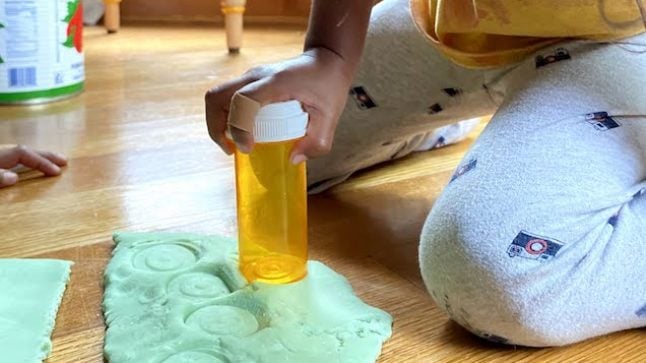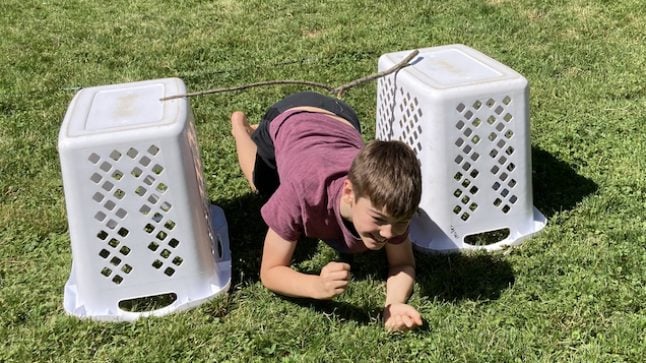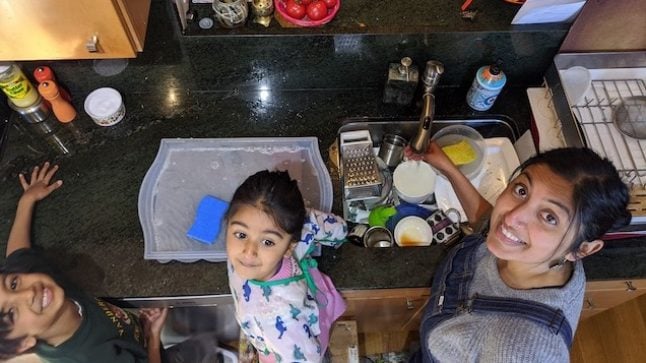Common Core: Geometry
As set out by the National Governors Association (NGA) and the Council of Chief State School Officers (CCSSO) in the Common Core State Standards Initiative. For more information, please visit the Geometry domain at the Common Core State Standards website.
Series: Ideas at Work
How to Use Digital Photos to Build a Mathematical Language Routine for Kids
June 6, 2022
It turns out that mathematical thinking is developed in conversation with others; asking students “how do you know that?” will reveal a child’s mathematical reasoning skills. The ability to explain one’s thinking is a cognitive leap that requires protected time for meaningful conversation.
- Topic: Sets, Number Sense
- Age/Grade Level: Pre-K, Kindergarten, 1st Grade, 2nd Grade, 3rd Grade
- Tags English Language Learner, Number Talks
Series: Ideas at Work October 14, 2020
Chores for Kids Can Help Them Find Math Around the House
With young children at home, there’s always cleaning to be done. So why not include them in completing the chores? Chores can engage everyone in the household in a little “math all around us” problem-solving.
- Topic: Precursor Concepts, Spatial Relationships
- Age/Grade Level: Infants, Toddlers, Pre-K, Kindergarten
- Tags Family Math
Series: Ideas at Work September 11, 2020
Homemade Playdough Recipe for Shape Fun
Stamping or imprinting with a homemade playdough recipe using everyday household items is an active way for children to explore the big ideas of shape.
- Topic: Precursor Concepts, Shape
- Age/Grade Level: Infants, Toddlers, Pre-K, Kindergarten, 1st Grade
- Tags Family Math
Series: Ideas at Work July 29, 2020
Putting Groceries Away is Hands-on Shape Activity for Young Children
Putting groceries away is necessary work for families. Sharing this work with our children turns an everyday task into a hands-on shape activity.
- Topic: Shape
- Age/Grade Level: Pre-K, Kindergarten, 1st Grade
- Tags Family Math, En Español
Series: Ideas at Work July 13, 2020
Taking Math Out for a Spin: Outside Activities for Kids That Have Math
Warm weather and more daylight hours mean now is a great time to take advantage of outdoor spaces. There are so many ways to incorporate math into your child’s outside activity.
- Topic: Measurement, Spatial Relationships
- Age/Grade Level: Pre-K, Kindergarten, 1st Grade, 2nd Grade, 3rd Grade
- Tags Play, Family Math
Series: Ideas at Work April 28, 2020
Dishing Up the Math: Tasks at Home Can Become Math Time
Every day dishes need to get cleaned, and every day dishes need to get put away. By involving children in tasks like doing the dishes, you can help them see mathematics in this work.
- Topic: Measurement, Spatial Relationships
- Age/Grade Level: Pre-K, Kindergarten, 1st Grade, 2nd Grade, 3rd Grade
- Tags Family Math, En Español
Series: Ideas at Work April 24, 2020
DIY Puzzles Develop Spatial Thinking
Jigsaw puzzles are a great way for children to develop their spatial thinking and problem-solving skills. Children enjoy doing all kinds of puzzles and making ones from materials found around the house keeps it fresh…
- Topic: Spatial Relationships
- Age/Grade Level: Pre-K, Kindergarten, 1st Grade, 2nd Grade, 3rd Grade
- Tags Games, Family Math, En Español
Series: Book Ideas March 23, 2020
At-Home Activity Cards: Shapes
Books can illustrate kindergarten and preschool shape concepts while introducing foundational Big Ideas of math. These activity cards can help take the learning to the home environment where parents and caregivers can spark such discussion.
- Topic: Shape
- Age/Grade Level: Pre-K, Kindergarten
- Tags Lois Ehlert, Tana Hoban, Roseanne Thong, Shapes Shapes Shapes, Round as a Tortilla, Color Farm, Color Zoo, Cubes Cones Cylinders & Spheres, download
Series: Book Ideas July 29, 2019
Different Types of Shapes and Nonexamples to Spark Geometric Learning
It’s up to us to find, share, and talk about a variety of shapes with children in ways that expand their understanding and build connections between the shapes drawn on paper and the concrete objects…
- Topic: Precursor Concepts, Shape
- Age/Grade Level: Infants, Toddlers, Pre-K, Kindergarten, 1st Grade
- Tags Tana Hoban, Attribute, Shapes Shapes Shapes, Now What? A Math Tale, Robie H. Harris
Series: Ideas at Work June 8, 2019
Build Tangram Shapes with Do-It-Yourself Puzzles
A tangram puzzle consists of seven pieces — five triangles and two quadrilaterals made from one square. Tangrams originated in China hundreds of years ago. They traveled to Europe in the 1800’s, where they gained…
- Topic: Spatial Relationships, Shape
- Age/Grade Level: Pre-K, Kindergarten, 1st Grade, 2nd Grade
- Tags Ann Tompert, Family Math, Grandfather Tang's Story, Play
Do the math.
Free videos.
Free newsletter packed with ideas.
Free professional learning modules.









